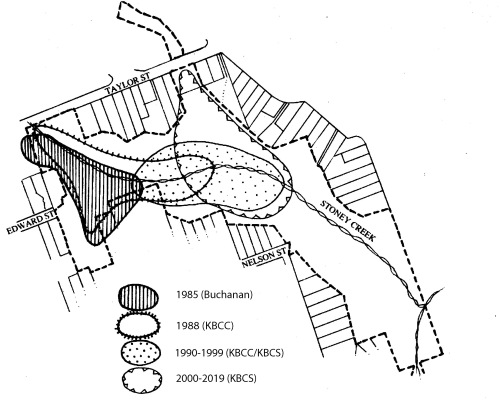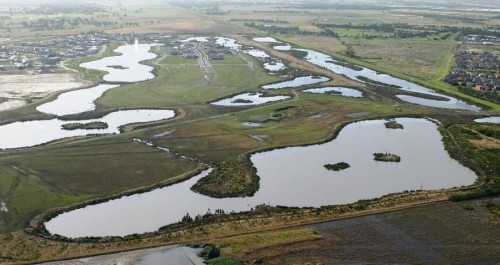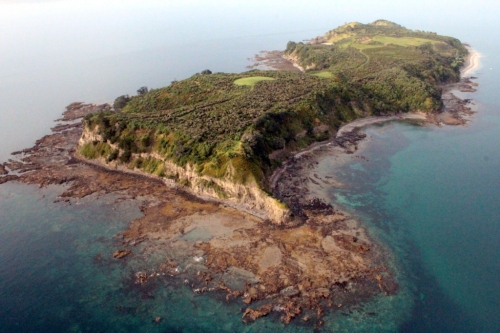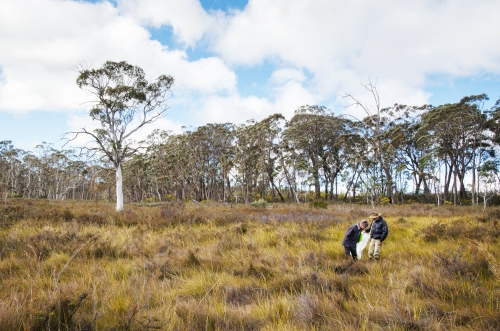Daniel Lunney, Alison Matthews, Chris Moon and John Turbill
[Update of EMR feature – Lunney, Daniel, Alison Matthews, Chris Moon and John Turbill (2002) Achieving fauna conservation on private land: Reflections on a 10-year project. Ecological Management & Restoration, 3:2, 90-96. https://onlinelibrary.wiley.com/doi/10.1046/j.1442-8903.2002.00100.x]
Key words: SEPP 44, Coffs Harbour, logging, urban development, New South Wales, ecological history, koala plan of management.
Introduction. Our 2002 paper in EMR focused on the local government area (LGA) of Coffs Harbour and reflected on our approach to meeting the challenge of finding a means of protecting populations of Koala (Phascolarctos cinereus) on private land before habitat removal brought about their local extinction. This was prompted by our 1986–1987 state-wide koala survey that found that koala populations had declined across New South Wales, largely as a result of habitat loss. The remaining koala stronghold, we identified at the time, was on the north coast, in areas such as in the rapidly expanding city of Coffs Harbour. Koalas in Coffs Harbour were found mostly on privately-owned land outside National Parks and Nature Reserves and State Forests.
It took 10 years (1990-2000) of struggle with politics, bureaucracy and vested interests to achieve a plan of management across one local government area (Coffs Harbour) to save koala habitat from the relentless clearing of private land. The reward for our efforts was a Comprehensive Koala Plan of Management (CKPoM), prepared under State Environmental Planning Policy 44 – koala habitat protection (SEPP 44), and adopted by Coffs Harbour City Council in 1999. SEPPs apply only to land over which local government has authority, not Crown Land, i.e. National Parks, Nature Reserves and State Forests. The Plan identified and ranked Koala habitat and set out criteria for minimizing local threats. It is a statutory instrument, gazetted in 2000 along with council’s Local Environmental Plan (LEP), which controls land-use planning. It was the first CKPoM in NSW and a demonstrated formula for undertaking such plans. Now in 2019, 20 years after the plan was formally adopted by Coffs Harbour City Council, and in the NSW parliament in 2000 as part of the Coffs Harbour LEP, the plan is still in place. We count that as a success. While revisions to both the SEPP and the Coffs Harbour CKPoM are in the wind, the 1999 plan still stands, as of October 2019.
Further, after five years of operation, Coffs Harbour council commissioned a strategic review of its CKPoM from the consultants, EcoLogical, which found that there was a 1.1% reduction in the area of primary koala habitat. In our view, such a small change over 5 years is an indication of the CKPoM’s impact in halting habitat loss on private land.

Figure 1. Historian, and co-worker, Antares Wells examining a document with items from the history of the Bellinger, the LGA immediately to the south of Coffs Harbour, as part of our study of the ecological history of the region. (Photo Dan Lunney 2013/)
Further studies. To add context to our work in Coffs Harbour, we undertook a range of further studies. These included an historical study, looking at the koala records from European settlement to 2000 through an ecological lens (Fig 1). The first wave of European settlers arrived in the early 1880s, and much of the initial development arose from logging. Collectively, the evidence identifies that the koala population of Coffs Harbour was widespread but never abundant, and that habitat loss has been relentless since European settlement. The transformation of a rural-forest mosaic to an urban landscape over the past four decades is the most recent stage in the incremental loss of habitat.
Also, in 2011, we undertook a repeat study of the koala population within Coffs Harbour LGA from our initial survey in 1990. Analyses showed that the koala population has endured between 1990 and 2011 and showed no evidence of a precipitous decline during this period. Rather, the population change was best characterised as stable to slowly declining.
The extensive koala datasets gathered since 1990 on the Coffs Harbour koala population are attractive for researchers and managers. They provide the basis for revisiting the LGA to look for change (Fig 2.) . Work in June 2019, for example, included the following: Department of Planning, Industry and Environment at Coffs Harbour is finalising a review of the Coffs Harbour LGA koala habitat study from funding by council; surveys completed in April 2019 revisited 68 of the original 119 sites we had selected in 1996, and 89 of those sites we had re-surveyed in 2011, and the total number of sites visited in the current survey was 176 in a report to Coffs Harbour council in September 2019.

Figure 2. Koala team standing in koala habitat near Bonville, Coffs Harbour LGA. From left to right, John Turbill, Martin Smith, Indrie Sonawane, Chris Moon and Martin Predavec. (Photo Dan Lunney 2013).
Mixed results. Rereading our original paper is unsettling. There is an enduring sense that the entire exercise, while locally worthwhile, has not translated into wider successes with respect to policy and implementation. Although our assessment of the success of the Coffs Harbour CKPoM is upbeat, the uptake of the concept by other councils has been modest. Some have opted for a koala plan of management, but not within the SEPP 44 framework, and others have contracted the preparation of the plans, but only using field survey data for koalas, not the citizen science component.
Among our reflections on our work is that the languages of planning, conservation and ecology need to be calibrated. Confusion has occurred because SEPP 44 refers to potential and core koala habitat when a Development Application (DA) is being assessed, but in the CKPoM in 1999 we used the terms primary, secondary and tertiary koala habitat. Adoption by local government of a CKPoM replaces the requirement to assess each individual DA for core habitat, because the CKPoM has mapped and ranked this habitat. In fact, the ease of seeing koala habitat on a map, ranked so that you know what development is possible, or not, within the particular ranking, expedites the DA process for all parties. This was a major selling point for Coffs Harbour council, along with our economic study which demonstrated that the value of having a koala population in the LGA exceeded the cost of implementing such a plan (Fig 3). While habitat ranking is appropriate for a CKPoM – a land-use planning and management instrument – one interpretation, a misguided one in our view, has been that primary habitat equals core habitat, and deems primary habitat in a CKPoM to be the only level of habitat to conserve. Such a view not only disregards the value of rankings for the purpose of planning, but also ignores the multiple ways that koalas need to use the landscape. We note that more recent plans have divided secondary habitat into secondary A and secondary B, but that does not change the principle of ranking. We also note that a recent choice is to use ‘core’ habitat in a CKPoM, although with a different approach to defining ‘core’, but this has yet to be consolidated in the proposed revised SEPP 44. On reflection, ‘core’ has become a problematic word because it implies that anything other than core can be ignored.
There have been considerable recent efforts to catch up on survey methods for koalas in State Forests. However, pressure remains on State Forests concerning their koala populations, such as the campaign by the National Parks Association of NSW for ‘The Great Koala National Park’ to add 175,000 ha of State Forests to existing protected areas to form a 315,000 ha reserve in the Coffs Harbour hinterland. National Parks and Nature Reserves are a central element in our efforts to conserve our fauna, but a transfer of State Forests to National Parks does not come to grips with the issue of the loss of habitat on private lands, including in situ habitat and linkages across the landscape.
SEPP 44 was promulgated in 1995, and while we recognise that it needs to be updated, our point remains that it has demonstrated potential to conserve koala habitat on private land, with an explicit role, indeed a key role, for local government. Strategies to conserve and restore koala habitat on private land—particularly on the more fertile lands, which are also the prime lands for farms and towns—will continue to be central to conserving the koala populations in NSW.

Figure 3. Economist Clive Hamilton explaining the economic advantages of conserving koalas in Coffs Harbour LGA. This presentation was given in Coffs Harbour at a national meeting for Ecological Economics. (Photo Dan Lunney 1996.)
Lessons learned and future directions. In 2019, our reflections on our 10-year study (1990-2000) allow us to conclude that identifying koala habitat on private land is possible, that plans to conserve it are acceptable, that the economic aspect is an important factor in the negotiations, and that local government has a role to play in this process. Since 2002 we have expanded our research horizon, crossing other disciplinary boundaries to encompass ecological history, using more sophisticated approaches to citizen science, stretching our geographical horizon to the north-west of NSW, incorporating the pervasive impact of climate change, and teasing out the contribution of koala care and rehabilitation and the value of detailed population studies such as by radio-tracking. We also conclude that local studies, especially repeated studies, e.g. at the LGA or Local Land Services (LLS) scale, are crucial, along with broad scale, periodic, state-wide surveys to keep track of the considerable individual differences across the geographic range of the koala.
Contact. Daniel Lunney, Department of Planning, Industry and Environment NSW (PO Box 1967, Hurstville NSW 2220 and the University of Sydney, NSW 2006. dan.lunney@environment.nsw.gov.au










































